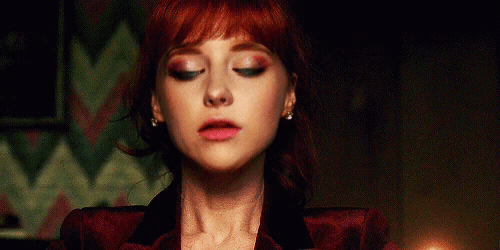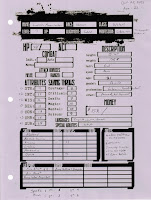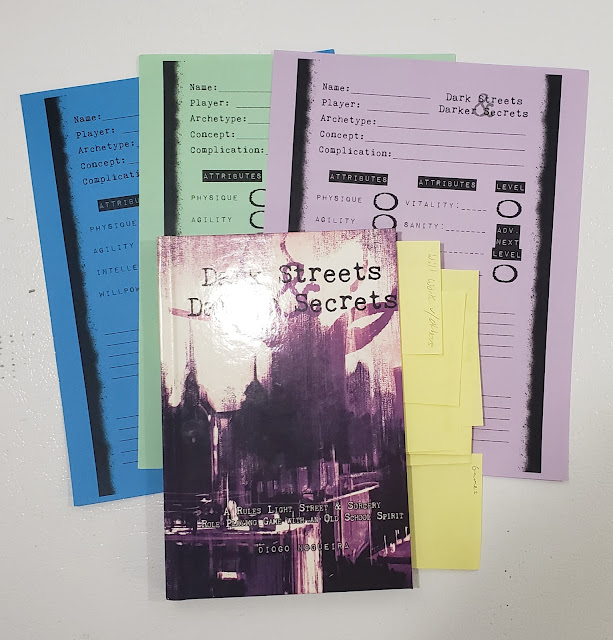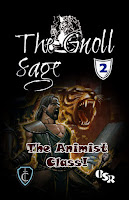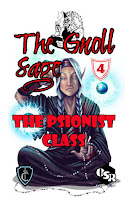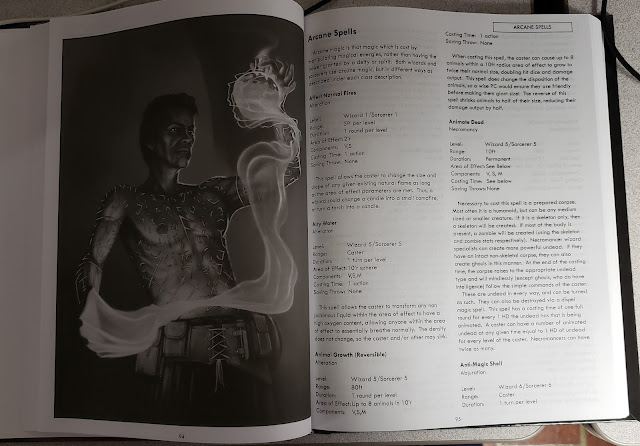Been thinking a lot about all the modern supernatural games I have (and I think I have all of them) and in particular the ones that have come out from the Old-School gaming scene. These games all cover roughly the same sort of topics and themes but they all do them in different ways that I keep thinking they would all work great together.
In other words, it sounds like a perfect topic for a Plays Well With Others.
So the games I am talking about are Dark Places & Demogorgons, We Die Young, Dark Streets & Darker Secrets, and my own NIGHT SHIFT. These are the big modern supernatural, occult horror games from the OSR.
I have reviewed these games in the past.
- Review: Survive This! Dark Places & Demogorgons
- SURVIVE THIS!! We Die Young RPG Core Rules (2021)
- Review: Dark Streets & Darker Secrets
I have covered many of these games in other Plays Well With Others too.
- Night Shift and Modern Supernatural Games
- Dark Places & Demogorgons: Cryptid Manual
- Kids Games, Dark Places & Demogorgons (with NIGHT SHIFT)
With the addition of Dark Streets & Darker Secrets to my occult library, I wanted to revisit some of these ideas. Though I want to take a different approach today.
With this Plays Well With Others, I am going to mention each game and talk about what can be used from that game in any of the other three. In some cases, this is easy like moving from Dark Places & Demogorgons to We Die Young which are essentially the same system. In others, it will be converting characters from one system to the other.
At the core of all four games (three systems) is the old-school, the OSR, design. All of these games have the same "godfather" as it were in Original or Basic D&D. They have the same uncle (mother's brother), the d20 SRD. And their mother is all the D&D games we all played and the supernatural, occult, horror and urban fantasy media we consumed when not playing.
Dark Streets & Darker SecretsThis is the newest game, for me, and the one on my mind the most. Thankfully it is also the one that has the most to offer all the games.
For starters, the classes can be imported rather easily into the other three games. In particular the Tough, the Nimble, and the Smart can be used as subtypes of the Veteran or Survivor in NIGHT SHIFT or as a class in We Die Young. Maybe not so much for DP&D since those are supposed to be kids. The Gifted of DS&DS is similar to the Supernatural in NS.
The real gift of DS&DS is all the tables. Someone online described the game as a great toolkit game. Some of the best ones to use in all games are the Complication table (p.20), Weird Items (p.32- 33), almost all the Gear. The Magic and Psychic backlash tables are also fun. ALL the artifact tables. The various "signs" in Chapter 7. In fact, pretty much all of Chapter 7 to be honest.
Survive This!!
Both Dark Places & Demogorgons and We Die Young from Bloat Games use the same Survive This!! basic rule system, so right out of the gate they are compatible with each other. Dark Places & Demogorgons focuses on kids in the 1980s and We Die Young on young adults in the 1990s. So there is a continuum there for any that wish to use it. There are plenty of "classes" in both games that can be used and mixed and matched. Like DS&DS there are a lot of great toolbox-like tables and ideas that can be imported into another game.
I can easily see a game then of people in their 30s in the 2000s with large chunks of DS&DS mixed into the Survive This!! system. Would this game be called "Survive This!! Dark Streets" or "Dark Streets, Dark Places, Darker Secrets & Demogorgons?" I don't know, but I LOVE the idea of kids experiencing weird shit in the 80s, taking a bunch of drugs to forget them in the 90s (both DS&DS and WDY have these) and finally having to deal with this shit all over again in 2000-2020s as older adults. Very "It" if you think about it.
The jewel though in the Survive This!! (and there are many) though HAS to be the DP&D Cryptid Manual. DS&DS takes a toolkit view on monsters. NIGHT SHIFT has a minimalist view (a very OD&D view if I can add) on monsters. But the Cryptid Manual gives us a proper monster book.
Of note. Both DS&DS and We Die Young use the newer D&D5-ish Advantage and Disadvantage mechanic. Albeit in slightly different ways. I have been using this in NIGHT SHIFT as well and find it works better for me than a simple +3 or +5 to rolls.
Also, both games have a Madness mechanic. I like the one in We Die Young much better. Bits from DS&DS could be added to this, but in general, I think I'd use the one in WDY.
We Die Young also has some really cool races that can help fill out the "Gifted" of DS&DS.
Don't forget you can get the new Hardcover version of Dark Places & Demogorns on Kickstarter now.
NIGHT SHIFT: Veterans of the Supernatural WarsI talk a lot about NIGHT SHIFT here and with good reason, I am quite proud of the work I have done it. It fills the void in my life left by the Buffy RPG and everything I wanted from all three editions of Chill, but never exactly got (no slight on Chill, fantastic game), a little more approachable and less nihilistic than Kult, and none of the baggage of The World of Darkness (though I do get the urge to play that again. My oldest want to give it a try sometime).
Dark Places & Demogorgons makes some assumptions in the game that makes it what it is. The characters are kids and there is also the Jeffersontown setting, all of which are central to the game and make it work.
Dark Street & Darker Secrets is on the other end of the spectrum with no assumed setting other than "The City" which also works fantastic for this game and one of it's great strengths.
In between those two, we have NIGHT SHIFT (and We Die Young, but I'll get to that). NIGHT SHIFT does not have a default setting. There are different levels of difficulty you can configure the game in, Cinematic, Realistic, or Gritty. DP&D would be Cinematic, DS&DS is the poster boy for Gritty, and WDY is around Realistic. So I would use ideas from those games to inform my choices in the three levels of NS and vice-versa.
What NIGHT SHIFT has to offer these other games are our "Night Worlds" or mini-settings. Any of these can be used in any of the other games and the other games can be used to add more details. Jason's "The Noctnurmverse" can be supplemented either by or used in DS&DS. The "City" in DS&DS becomes the Noctnurmverse's Pittsburgh. Or dialing back the Way-Back Machine use it with We Die Young in the 1990s. My own "Generation HEX" benefits from the ideas on playing kids in DP&D. You could even take Generation HEX and play it as a DP&D setting if you wanted. My "Ordinary World" can be used in DS&DS IF you ever decide to move out of the city into the suburbs.
I already talked a lot about how NIGHT SHIFT and Dark Places & Demogorgons can be used together. The same logic applies when adding in the other two games. In fact one place where this might work great is my own Sunny Valley, OH game of the Buffyverse in the 1980s rather than the late 90s/early 2000s. This works well since a.) NIGHT SHIFT was made to fit the "Buffy-shaped" hole in my life and b.) DS&DS takes a lot of cues from and was influenced by Buffy in all media. I might just be the best melting pot for all these games. Or crucible. Time will tell.
Putting it All Together
Honestly, there are just too many ways to combine these four games into something you can use. Start with one and add what you need. Start with two and be pickier about what you add from the others. One of the ways I am using it is in my Life-Path Development ideas. Each game represents a different point the characters' lives and each is used to model that time. The obvious reasons are that DP&D takes place in the 80s with kids, WDY in the 90s with younger adults, and DS&DS and NIGHT SHIFT go beyond that. To go with personal experience, I was living in Chicago proper in the mid to late 90s and then in the suburbs after that. To use my ordinary world example my progression would look like this:
DP&D (high school, small town) -> WDY (college, college town) -> DS&DS (grad school, city) -> NIGHT SHIFT (adulthood, suburbs).
In a weird way, it makes sense to me. But I am not stating up myself. I don't live in a magical world, I live in this one. BUT I do have my Drosophila melanogaster of these sorts of experiments, Willow and Tara. I have done stats for them for Dark Places & Demogorgons and NIGHT SHIFT. Doing ones for We Die Young and Dark Streets & Darker Secrets would be easy enough. BUT. Those are not the same characters really. They fall under my "Alternate Reality" versions rather than "Lifespan or Lifepath Development." Though doing DS&DS versions of Willow and Tara should be in my future.
No for this I need a character that has been around for a while, for that I am going to have to turn to my Iconic Witch Larina.
Fortunately for me, the witch is one of the few character classes/archetypes/concepts that can be found in all these games (the weird psychic is as well, but witches are my thing). So building a witch feels right.
I worked up all the sheets and this is what I ended up with. Purple is the color of all of Larina's sheets. Click for larger.
Dark Places & Demogorgons
It's 1984 and Larina is 14 and 4th level. She lives in a small town where her mom runs a spice shop and her dad is a Professor of Anthropology and teaches music. She is called "creepy girl" by the kids in school. At this point, she is shy and can't quite understand why others can't see the strange things all around them.
Most of these adventures are of the "Scooby-Doo" sort; short ones that are resolved by the end. Easily Monster of Week sorts.
We Die Young
We are moving to the early 90s now and she is 7th level. Larina is in grad school and is now Larina Macalester. She was married at age 19 but obviously, it is not working out well. She is living in Chicago while her estranged husband is still living in Ireland. Her stats nudge up a little but she largely is similar to her 1DP&D version. There are some differences between the two types of Witch classes (and DP&D still has others) but nothing I consider earth-shattering. I did get to add her two tattoos. One is a protection tattoo (a large Triple Moon Goddess on her back) and one on her left wrist that allows her to cast a magic bolt.
Dark Streets & Darker Secrets
Things are getting darker. Larina is now 35, 10th level, and back to going back to using "Nichols" as her last name. Her complication is she is hiding from her ex-husband who was in the IRA. (NOTE: I actually played through this back in the early 2000s. The big twist was that while she was hiding out, her ex had moved on and was living his own life with his new wife.) I wanted to use my new idea for Sanity by having it as Intellect + Willpower /2. BUT for Larina here both scores are 17 giving me an average of 17.
NIGHT SHIFT
Here is the one closest to my heart, obviously. She has more spells, but this is expected at 13th level.
As expected the powers don't always match up right and I could have taken more care in aligning the spells with each version. But I figure that these changes can be chalked up to learning and experiences. I do feel that all versions reflect the character at the time well.
Looking forward to trying this with other characters to see how they work out. Also, I am keeping all of these books together to use as needed. By themselves, they give me a wonderful experience. Together they give me an epic experience.






